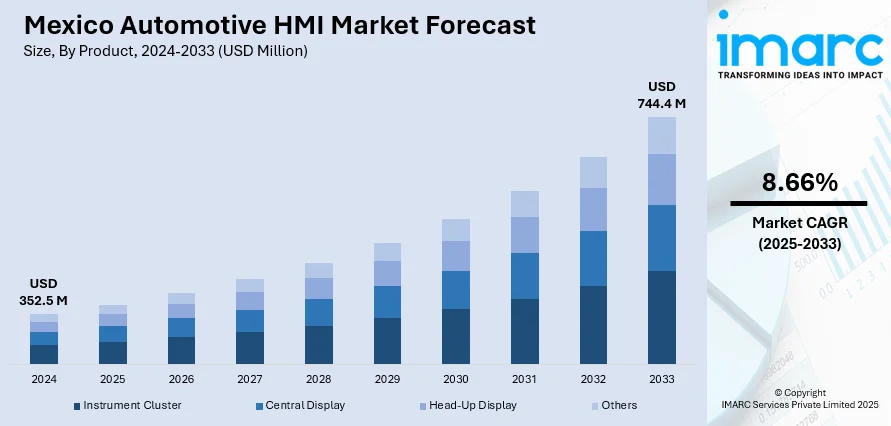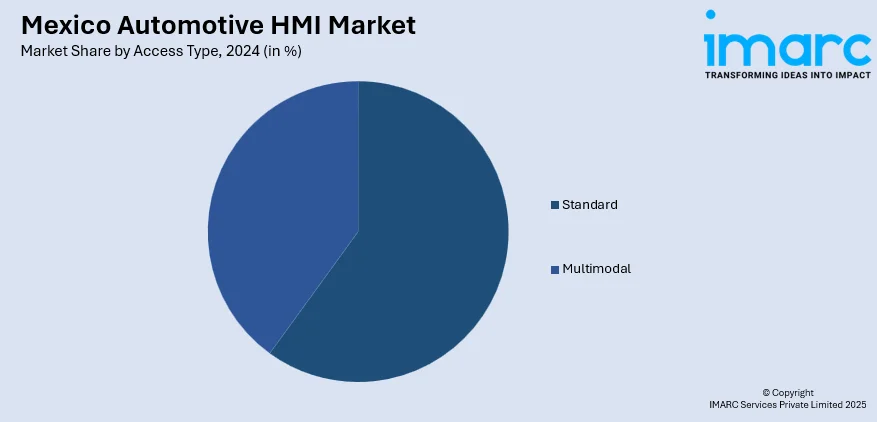
Mexico Automotive HMI Market Size, Share, Trends and Forecast by Product, Access Type, Technology, Vehicle Type, and Region, 2025-2033
Mexico Automotive HMI Market Overview:
The Mexico automotive HMI market size reached USD 352.5 Million in 2024. Looking forward, IMARC Group expects the market to reach USD 744.4 Million by 2033, exhibiting a growth rate (CAGR) of 8.66% during 2025-2033. The market is propelled by the increasing demand for advanced driver assistance systems (ADAS), the integration of artificial intelligence (AI) and machine learning for enhanced user experiences, and the growing emphasis on safety and regulatory compliance. Additionally, the rise of electric and autonomous vehicles necessitates the development of sophisticated HMI systems to manage complex functionalities, thereby facilitating Mexico automotive HMI market share.
|
Report Attribute
|
Key Statistics
|
|---|---|
|
Base Year
|
2024 |
|
Forecast Years
|
2025-2033
|
|
Historical Years
|
2019-2024
|
| Market Size in 2024 | USD 352.5 Million |
| Market Forecast in 2033 | USD 744.4 Million |
| Market Growth Rate 2025-2033 | 8.66% |
Mexico Automotive HMI Market Trends:
Integration of Artificial Intelligence and Voice Recognition
The application of artificial intelligence (AI) and voice recognition technologies is revolutionizing the Mexican automotive Human-Machine Interface (HMI) market. These technologies enable vehicles to deliver personalized experiences, adapting to the personal tastes and habits of individual drivers. AI algorithms analyze data to forecast user needs, while voice recognition enables hands-free control of many vehicle features, enhancing convenience and safety. This trend is in line with the global shift towards more human-centric and responsive in-car tech, positioning Mexican car makers ahead of the curve in HMI innovation. For instance, in January 2024, Rightware, in partnership with Silo AI, enhanced automotive Human-Machine Interface (HMI) design using generative AI. Their Kanzi One toolchain, used by over 50 car brands, integrates AI to accelerate UI design workflows. The collaboration enables automated creation of custom digital cockpits, allowing designers to easily generate and test user interfaces in seconds. This innovation streamlines production, supports regional customization, and merges automated and manual design control, offering a faster, more flexible approach to building interactive, production-ready vehicle displays.

To get more information of this market, Request Sample
Emphasis on Safety and Regulatory Compliance
Safety and regulatory compliance are paramount in the development of automotive Human-Machine Interface (HMI) systems in Mexico. Manufacturers are increasingly focusing on creating interfaces that minimize driver distraction and adhere to stringent safety standards. Features such as adaptive cruise control, lane-keeping assistance, and collision warning systems are being seamlessly integrated into HMI platforms, which are acting as crucial drivers for Mexico automotive HMI market growth. Additionally, compliance with international regulations ensures that Mexican automotive products meet global market requirements, enhancing their competitiveness. This emphasis on safety and regulatory adherence not only protects consumers but also bolsters the reputation of Mexico's automotive industry on the world stage. For instance, in April 2024, Infineon Technologies introduced the PSoC™ 4 HVMS microcontroller family for automotive applications, featuring high-voltage integration and advanced analog capabilities such as CAPSENSE™ and inductive sensing. Designed for touch-enabled HMI systems and smart sensing applications, these space-efficient microcontrollers are ideal for steering wheels, HVAC controls, and interior lighting. Fully compliant with ISO26262 (ASIL-B) and ISO21434 standards, they offer enhanced functional safety and cybersecurity. Supporting 12V power and LIN/CXPI communication, the family comes with robust software tools for accelerated development.
Mexico Automotive HMI Market Segmentation:
IMARC Group provides an analysis of the key trends in each segment of the market, along with forecasts at the country/regional levels for 2025-2033. Our report has categorized the market based on product, access type, technology, and vehicle type.
Product Insights:
- Instrument Cluster
- Central Display
- Head-Up Display
- Others
The report has provided a detailed breakup and analysis of the market based on the product. This includes instrument cluster, central display, head-up display, and others.
Access Type Insights:

- Standard
- Multimodal
A detailed breakup and analysis of the market based on the access type have also been provided in the report. This includes standard and multimodal.
Technology Insights:
- Visual Interface
- Acoustic
- Mechanical
- Others
The report has provided a detailed breakup and analysis of the market based on the technology. This includes visual interface, acoustic, mechanical, and others.
Vehicle Type Insights:
- Passenger Cars
- Commercial Vehicles
A detailed breakup and analysis of the market based on the vehicle type have also been provided in the report. This includes passenger cars and commercial vehicles.
Regional Insights:
- Northern Mexico
- Central Mexico
- Southern Mexico
- Others
The report has also provided a comprehensive analysis of all the major regional markets, which include Northern Mexico, Central Mexico, Southern Mexico, and others.
Competitive Landscape:
The market research report has also provided a comprehensive analysis of the competitive landscape. Competitive analysis such as market structure, key player positioning, top winning strategies, competitive dashboard, and company evaluation quadrant has been covered in the report. Also, detailed profiles of all major companies have been provided.
Mexico Automotive HMI Market News:
- In February 2025, Unity Technologies was selected by Toyota Motor Corporation to develop the Graphical User Interface (GUI) for its next-generation in-car Human Machine Interface (HMI). This collaboration leverages Unity’s real-time 3D capabilities to enhance user experience, streamline development, and improve efficiency across Toyota’s digital cockpit systems. Toyota’s engineers benefit from Unity’s user-friendly tools, enabling faster innovation and development. The partnership marks a significant step in integrating advanced graphics into the automotive sector, aiming to deliver more immersive and efficient in-car technologies.
- In January 2025, DXC Technology extended its partnership with Ferrari to develop next-generation Human Machine Interface (HMI) systems for its vehicles. The collaboration enhances Ferrari's in-car experience with high-performance infotainment, seen in the newly launched F80 supercar. DXC's bespoke software supports multiple displays, offering immersive visuals, real-time performance data, and dual driving modes for road and track. The partnership underscores DXC’s role in automotive innovation, leveraging its experience to help Ferrari stay ahead in advanced digital cockpit development and elevate user experience.
Mexico Automotive HMI Market Report Coverage:
| Report Features | Details |
|---|---|
| Base Year of the Analysis | 2024 |
| Historical Period | 2019-2024 |
| Forecast Period | 2025-2033 |
| Units | Million USD |
| Scope of the Report | Exploration of Historical Trends and Market Outlook, Industry Catalysts and Challenges, Segment-Wise Historical and Future Market Assessment:
|
| Products Covered | Instrument Cluster, Central Display, Head-Up Display, Others |
| Access Types Covered | Standard, Multimodal |
| Technologies Covered | Visual Interface, Acoustic, Mechanical, Others |
| Vehicle Types Covered | Passenger Cars, Commercial Vehicles |
| Regions Covered | Northern Mexico, Central Mexico, Southern Mexico, Others |
| Customization Scope | 10% Free Customization |
| Post-Sale Analyst Support | 10-12 Weeks |
| Delivery Format | PDF and Excel through Email (We can also provide the editable version of the report in PPT/Word format on special request) |
Key Questions Answered in This Report:
- How has the Mexico automotive HMI market performed so far and how will it perform in the coming years?
- What is the breakup of the Mexico automotive HMI market on the basis of product?
- What is the breakup of the Mexico automotive HMI market on the basis of access type?
- What is the breakup of the Mexico automotive HMI market on the basis of technology?
- What is the breakup of the Mexico automotive HMI market on the basis of vehicle type?
- What is the breakup of the Mexico automotive HMI market on the basis of region?
- What are the various stages in the value chain of the Mexico automotive HMI market?
- What are the key driving factors and challenges in the Mexico automotive HMI market?
- What is the structure of the Mexico automotive HMI market and who are the key players?
- What is the degree of competition in the Mexico automotive HMI market?
Key Benefits for Stakeholders:
- IMARC’s industry report offers a comprehensive quantitative analysis of various market segments, historical and current market trends, market forecasts, and dynamics of the Mexico automotive HMI market from 2019-2033.
- The research report provides the latest information on the market drivers, challenges, and opportunities in the Mexico automotive HMI market.
- Porter's five forces analysis assist stakeholders in assessing the impact of new entrants, competitive rivalry, supplier power, buyer power, and the threat of substitution. It helps stakeholders to analyze the level of competition within the Mexico automotive HMI industry and its attractiveness.
- Competitive landscape allows stakeholders to understand their competitive environment and provides an insight into the current positions of key players in the market.
Need more help?
- Speak to our experienced analysts for insights on the current market scenarios.
- Include additional segments and countries to customize the report as per your requirement.
- Gain an unparalleled competitive advantage in your domain by understanding how to utilize the report and positively impacting your operations and revenue.
- For further assistance, please connect with our analysts.
 Request Customization
Request Customization
 Speak to an Analyst
Speak to an Analyst
 Request Brochure
Request Brochure
 Inquire Before Buying
Inquire Before Buying




.webp)




.webp)












